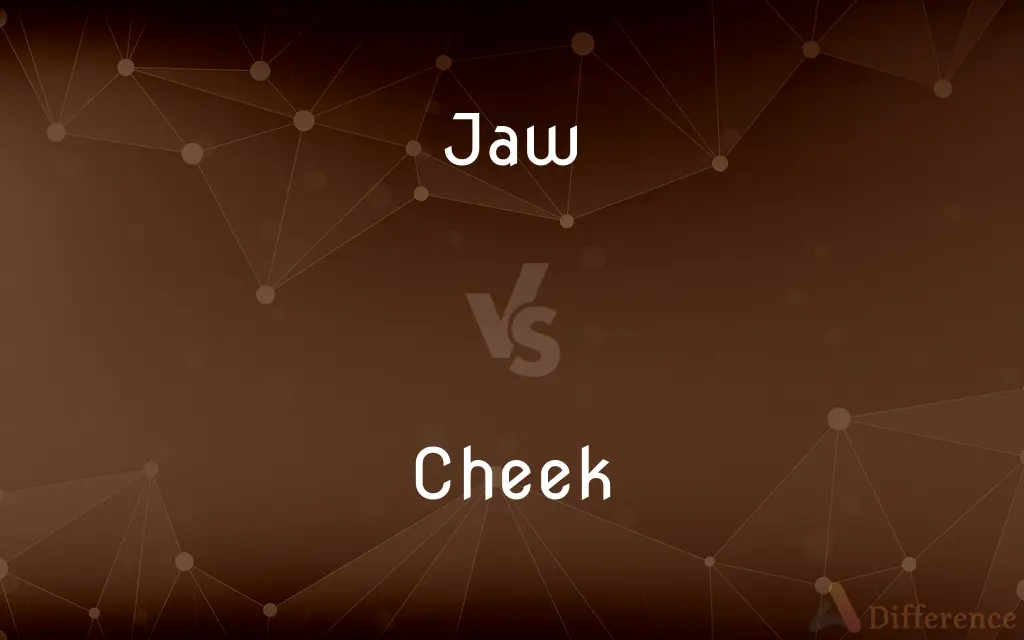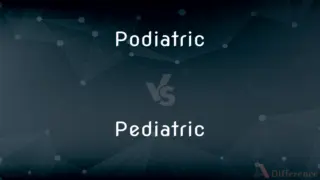Jaw vs. Cheek — What's the Difference?
Edited by Tayyaba Rehman — By Fiza Rafique — Updated on April 5, 2024
The jaw forms the structure of the mouth and chin, pivotal in eating and speaking, while cheeks form the sides of the face, playing roles in expression and facial contour.

Difference Between Jaw and Cheek
Table of Contents
ADVERTISEMENT
Key Differences
The jaw, comprising both the maxilla (upper jaw) and mandible (lower jaw), is essential for biting, chewing, and speech articulation. It supports the teeth and provides attachment points for muscles involved in opening and closing the mouth. On the other hand, the cheeks consist of skin, fat, and muscles, notably the buccinator muscle, which aids in chewing and smiling. They contribute to facial expressions, the contour of the face, and hold food between the teeth for chewing.
While the jawbone provides structural support and is critical for oral functions, including the development of speech and maintaining the alignment of teeth, the cheeks serve as a soft cushion for the jaw during chewing, preventing damage to the mucosa inside the mouth. This distinction highlights the interplay between hard and soft tissues in the oral cavity for efficient function.
The development and health of the jaw can significantly influence overall facial structure and aesthetics, as issues with the jawbone or temporomandibular joint (TMJ) can lead to pain, difficulty eating, and changes in facial appearance. Conversely, the cheeks can affect facial aesthetics through their volume and shape, with variations in fat distribution or muscle tone influencing the perception of facial health and beauty.
In terms of medical concerns, the jaw is susceptible to conditions such as TMJ disorders, dental problems, and osteonecrosis. Meanwhile, the cheeks can be affected by cosmetic issues, such as sagging due to aging or weight loss, and medical conditions like parotitis (inflammation of the parotid glands).
Regarding surgical and cosmetic procedures, the jaw may be the focus of orthodontic treatments, orthognathic surgery for alignment, and dental implants for tooth replacement. The cheeks are often targeted in cosmetic surgery, such as cheek augmentation for enhancing facial contours and buccal fat removal for a more defined facial structure.
ADVERTISEMENT
Comparison Chart
Composition
Bone (maxilla and mandible), teeth, muscles
Skin, fat, muscles (notably the buccinator)
Primary Function
Biting, chewing, speech
Facial expression, contour
Health Concerns
TMJ disorders, dental issues
Sagging, parotitis
Role in Facial Aesthetics
Determines structure, affects alignment
Influences contour, expression
Surgical Focus
Orthodontic treatments, orthognathic surgery
Cheek augmentation, buccal fat removal
Compare with Definitions
Jaw
Subject to various health issues.
Conditions like TMJ disorders can significantly affect the jaw's functionality.
Cheek
Forms the sides of the face.
The cheeks are composed of skin, fat, and muscle, contributing to the face's shape.
Jaw
Target for specific surgeries.
Orthognathic surgery is performed to correct misalignments of the jaw.
Cheek
Influenced by volume and shape.
Variations in cheek fat distribution affect the perception of health and beauty.
Jaw
Structure of the mouth and chin.
The jaw includes both the maxilla and mandible, providing the framework for teeth and facial shape.
Cheek
Can be affected by cosmetic issues.
Loss of cheek fat can lead to a more aged appearance.
Jaw
Influences facial aesthetics.
The alignment and health of the jaw directly impact one's facial appearance.
Cheek
Role in expression and facial contour.
The cheeks play a crucial role in smiling and other facial expressions.
Jaw
Pivotal in eating and speaking.
The movement of the jaw is essential for chewing food and articulating words.
Cheek
Subject to cosmetic surgery.
Cheek augmentation is sought for enhancing facial contours.
Jaw
A conversation or chat.
Cheek
The cheeks (Latin: buccae) constitute the area of the face below the eyes and between the nose and the left or right ear. "Buccal" means relating to the cheek.
Jaw
The jaw is any opposable articulated structure at the entrance of the mouth, typically used for grasping and manipulating food. The term jaws is also broadly applied to the whole of the structures constituting the vault of the mouth and serving to open and close it and is part of the body plan of humans and most animals.
Cheek
The fleshy part of either side of the face below the eye and between the nose and ear.
Jaw
Either of two bony or cartilaginous structures that in most vertebrates form the framework of the mouth and hold the teeth.
Cheek
Something resembling the cheek in shape or position.
Jaw
The mandible or maxilla or the part of the face covering these bones.
Cheek
Either of the buttocks.
Jaw
Any of various structures of invertebrates that have an analogous function to vertebrate jaws.
Cheek
Impertinent boldness
Had the cheek to insult his hosts.
Jaw
Either of two opposed hinged parts in a mechanical device.
Cheek
To speak impudently to.
Jaw
Jaws The walls of a pass, canyon, or cavern.
Cheek
(anatomy) The soft skin on each side of the face, below the eyes; the outer surface of the sides of the oral cavity.
Jaw
Jaws A dangerous situation or confrontation
The jaws of death.
Cheek
The lower part of the buttocks that is often exposed beneath very brief underwear, swimwear, or extremely short shorts.
Jaw
Impudent argument or back talk
Don't give me any jaw.
Cheek
Impudence.
You’ve got some cheek, asking me for money!
Jaw
To talk vociferously; jabber.
Cheek
One of the genae, flat areas on the sides of a trilobite's cephalon.
Jaw
To talk; converse.
Cheek
One of the pieces of a machine, or of timber or stonework, that form corresponding sides or a similar pair.
The cheeks of a vice
The cheeks of a gun carriage'
Jaw
One of the bones, usually bearing teeth, which form the framework of the mouth.
Cheek
(nautical) pump-cheek, pump-cheeks, a piece of wood cut out fork-shaped in which the brake is fastened by means of a bolt and can thus move around and move the upper box of the pump up and down
Jaw
The part of the face below the mouth.
His jaw dropped in amazement.
Cheek
(in plural) The branches of a bridle bit. .
Jaw
(figuratively) Anything resembling the jaw of an animal in form or action; especially plural, the mouth or way of entrance.
The jaws of a pass; the jaws of darkness; the jaws of death.
Cheek
Either side of an axehead.
Jaw
A notch or opening.
Cheek
(metalworking) The middle section of a flask, made so that it can be moved laterally, to permit the removal of the pattern from the mould.
Jaw
A notched or forked part, adapted for holding an object in place.
The jaw of a railway-car pedestal.
Cheek
To be impudent towards.
Don't cheek me, you little rascal!
Jaw
One of a pair of opposing parts which are movable towards or from each other, for grasping or crushing anything between them.
The jaws of a vise; the jaws of a stone-crushing machine.
Cheek
To pull a horse's head back toward the saddle using the cheek strap of the bridle.
The squirrel cheeked some nuts before heading back to it's nest.
Jaw
(nautical) The inner end of a boom or gaff, hollowed in a half circle so as to move freely on a mast.
Cheek
The side of the face below the eye.
Jaw
Impudent, abusive or worthless talk.
Cheek
The cheek bone.
Jaw
(slang) Axle guard.
Cheek
Those pieces of a machine, or of any timber, or stone work, which form corresponding sides, or which are similar and in pair; as, the cheeks (jaws) of a vise; the cheeks of a gun carriage, etc.
Jaw
(snooker) The curved part of the cushion marking the entry to the pocket.
Cheek
The branches of a bridle bit.
Jaw
(transitive) To assail or abuse by scolding.
Cheek
A section of a flask, so made that it can be moved laterally, to permit the removal of the pattern from the mold; the middle part of a flask.
Jaw
(intransitive) To scold; to clamor.
Cheek
Cool confidence; assurance; impudence.
Jaw
To talk; to converse.
Cheek
To be impudent or saucy to.
Jaw
(of a ball) To stick in the jaws of a pocket.
Cheek
Either side of the face below the eyes
Jaw
(used in certain set phrases like jaw harp, jaw harpist and jaw's-trump)
Cheek
An impudent statement
Jaw
One of the bones, usually bearing teeth, which form the framework of the mouth.
Cheek
Either of the two large fleshy masses of muscular tissue that form the human rump
Jaw
Fig.: Anything resembling the jaw of an animal in form or action; esp., pl., the mouth or way of entrance; as, the jaws of a pass; the jaws of darkness; the jaws of death.
Cheek
Impudent aggressiveness;
I couldn't believe her boldness
He had the effrontery to question my honesty
Jaw
A notch or opening.
Cheek
Speak impudently to
Jaw
The inner end of a boom or gaff, hollowed in a half circle so as to move freely on a mast.
Jaw
Impudent or abusive talk.
Jaw
To scold; to clamor.
Jaw
To talk idly, long-windedly, or without special purpose.
Jaw
To assail or abuse by scolding.
Jaw
The part of the skull of a vertebrate that frames the mouth and holds the teeth
Jaw
The bones of the skull that frame the mouth and serve to open it; the bones that hold the teeth
Jaw
Holding device consisting of one or both of the opposing parts of a tool that close to hold an object
Jaw
Talk socially without exchanging too much information;
The men were sitting in the cafe and shooting the breeze
Jaw
Talk incessantly and tiresomely
Jaw
Chew (food);
He jawed his bubble gum
Chew your food and don't swallow it!
The cows were masticating the grass
Jaw
Censure severely or angrily;
The mother scolded the child for entering a stranger's car
The deputy ragged the Prime Minister
The customer dressed down the waiter for bringing cold soup
Common Curiosities
Are there treatments to change jaw and cheek appearance?
Yes, treatments range from orthodontic interventions for the jaw to cosmetic surgeries like cheek augmentation.
How do cheeks contribute to facial expressions?
Cheeks, through their muscle movements and volume, play a vital role in expressing emotions such as happiness through smiling.
Can problems with the jaw affect eating?
Yes, issues like TMJ disorders or misalignment can make chewing difficult and painful.
What constitutes the jaw?
The jaw consists of the maxilla (upper jaw) and the mandible (lower jaw), supporting teeth and enabling chewing.
Can dental problems impact the jaw?
Absolutely, dental issues can lead to jaw pain, misalignment, and TMJ disorders.
What affects cheek appearance?
Factors include age, genetics, fat distribution, and muscle tone.
Can the cheeks be slimmed down surgically?
Yes, through procedures like buccal fat removal, which reduces cheek volume for a more defined facial structure.
Why might someone undergo cheek augmentation?
To enhance facial contours, increase volume, or correct asymmetries for aesthetic reasons.
What are common jaw surgeries?
Orthognathic surgery for realignment and dental implants are common procedures targeting the jaw.
How do the jaw and cheeks work together during eating?
The jaw moves to chew food, while the cheeks keep the food between the teeth for efficient grinding.
What role does the buccinator muscle play in the cheeks?
It aids in chewing by pushing food towards the teeth and is involved in facial expressions.
How does jaw alignment affect facial aesthetics?
Proper jaw alignment contributes to a balanced, symmetrical facial appearance.
How do health issues in the cheeks manifest?
Conditions like parotitis cause swelling and pain in the cheeks, affecting overall facial appearance.
How does aging affect the cheeks?
Aging can lead to fat volume loss and skin elasticity reduction, causing the cheeks to sag.
What is TMJ disorder?
A condition affecting the temporomandibular joint, leading to pain, difficulty opening the mouth, and jaw clicking.
Share Your Discovery

Previous Comparison
Podiatric vs. Pediatric
Next Comparison
Waiter vs. ButlerAuthor Spotlight
Written by
Fiza RafiqueFiza Rafique is a skilled content writer at AskDifference.com, where she meticulously refines and enhances written pieces. Drawing from her vast editorial expertise, Fiza ensures clarity, accuracy, and precision in every article. Passionate about language, she continually seeks to elevate the quality of content for readers worldwide.
Edited by
Tayyaba RehmanTayyaba Rehman is a distinguished writer, currently serving as a primary contributor to askdifference.com. As a researcher in semantics and etymology, Tayyaba's passion for the complexity of languages and their distinctions has found a perfect home on the platform. Tayyaba delves into the intricacies of language, distinguishing between commonly confused words and phrases, thereby providing clarity for readers worldwide.















































